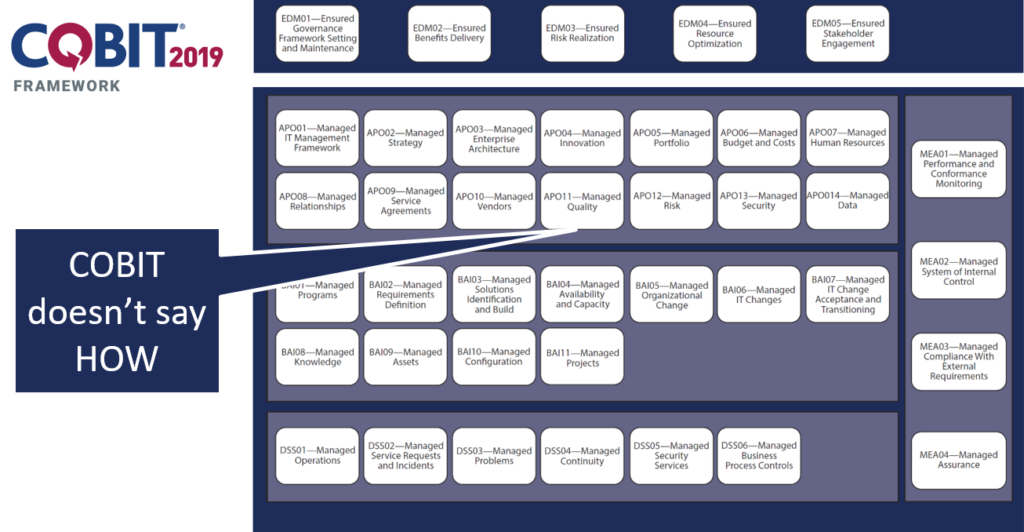Do you know what IT quality is? Do you manage IT Quality? Can you make IT quality visible?
Topic of quality is mentioned in many governance models, but there are many confusion about the meaning of word quality,
Here is brief summary of the most used approaches in the light of IT Quality Index logic:
- ISO/IEC 9001, 20000
- COBIT
- SFIA
- EFQM
- IT Quality Index
ISO/IEC 9001/2000
Quality definition: “The degree to which a set of inherent characteristics fulfils requirements”.
In IT management this logic is translated into service meeting customer requirements, in other words when service provider meets agreed SLA, then quality is delivered. ISO/IEC works with the word “customer”, who is external to service provider, thus primarily targeted to external relationships. If we apply this logic to managing internal IT quality, systemic approach is missing, as the role of IT is not just meeting customers’ requirements.
This ISO9001 approach is substantially different from IT Quality Index perspective, where quality is the degree of excellence, compared to similar kind of things.
COBIT 2019
COBIT is defining 40 Governance and management objectives, where quality is referenced in process APO11 Managed quality.
“Define and communicate quality requirements in all processes, procedures and related enterprise outcomes. Enable controls, ongoing monitoring, and the use of proven practices and standards in continuous improvement and efficiency efforts.
In ITQI there is good match with COBIT thinking and approach, as QMS. There is still visible inherent logic of customer defining requirements, absorbing ISO approach of customer and service provider split.
SFIA – skills framework for the information age
SFIA is well aligned with ITQI approach, understanding quality as a complex, multidimensional system.
Skill QUMG Quality management is defined as:
“Quality management establishes within an organisation a culture of quality and a system of processes and working practices to deliver the organisation’s quality objectives. This involves the application of techniques for the monitoring and improvement of the quality of any aspect of a function, processes, products, services or data. The achievement of, and maintenance of compliance to, national and international standards, as appropriate, and to internal policies, including those relating to quality, service, sustainability and security.”
IT Quality Index is compliant with this approach, building on top of it, adding systems thinking layer. ITQI and SFIA are well complementing each other, SFIA skills QUMG, MEAS, QUAS, CORE are supported with ITQI trainings.
EFQM – European Foundation for Quality Management
EFQM Excellence Model is a widely-used Business Excellence Framework in Europe, using the Excellence Model to improve performance and increase their bottom-line. Promoted by the European Foundation for Quality Management, this model represents a framework for organisational management systems, aiming to offer support to organisations in gaining competitive advantage.
EFQM is not IT focused, nevertheless it’s using similar logic as ITQI- multi criteria assessment, with defined process and processing method.
It’s using 1000 points scale, covering 7 categories.
IT Quality Index is built with similar underlying principles, the major differences are
- target use, EFQM is for assessment of the whole organisation management system, while IT Quality Index is focused on IT management quality.
- scale 1000 points vs. 0-100% used in ITQI
IT Quality Index
IT Quality Index is using systemic approach to IT quality, where IT is an intergral part of the business. IT Quality is defined as:
“A multi-dimensional entity where every dimension expresses a level of adoption of widely accepted best practices and the non presence of bad practices.”
IT Quality is expressed in the form of the IT QUALITY INDEX, which represents a measurement of all quality dimensions based on a consistent and documented process performed by the Accredited IT Quality Expert. ITQI is using 0-100% scale, and allows for Quality/Costs benchmarking, unique feature not covered in other quality management methods.
Resources efficiency is the guiding logic of IT quality assessment and management, so ITQI is fast, efficient method, deliverable within 2-3 weeks via mini consultancy project. For CIO it means ability to refocus from pure IT costs management to properly balanced IT Quality and costs.
For modern CIO this tools is making quality visible and should be considered for adoption where IT is not perceived as just costs center, but more strategic role of IT is expected.
Final remark
Recently we extended ITQI processing method so additional ITQI output can be generated, enabling transformation percent scale into 1000 points scale used in EFQM, which helps organisations using EFQM model to better align with ITQI % scale.



